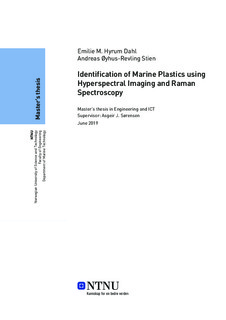| dc.description.abstract | Dagens Næringsliv (DN) hadde følgende overskrift 28. Mai i år (forfatter: Jørn Aass); ”Alarmerende forskning: Plast i havet påvirker oksygenet vi puster inn”. Plastforsøpling påvirker havet, som igjen er en sentral del av livet på jorden – både i vann og på land. Likevel, blir ikke havet tatt vare på. I dag er plastforurensning et faktum, både på de høyeste fjelltoppene og i de laveste havgropene. Med sin brede anvendelighet gjennomsyrer forurensningen nesten alle aspekter av det moderne liv.
Veien mot et rent hav inneholder flere etapper og krever, på det minste, en kartlegging av havrommet for å bestemme kritiske områder. Dette krever en omgående utvikling av in situ deteksjonsmetoder. Hyperspektral avbildning og Raman spektroskopi kan være slike teknologier. I prinsippet skal de begge kunne trekke ut den kjemiske strukturen til det observerte objektet ved å samle spektrale signaturer fra områdene belyst. Denne rapporten vil dermed forsøke å avdekke om det er mulig å klassifisere mikroplast under vann, ved å identifisere deres respektive spektrale signaturer. Studiet som støtter avhandlingen, omfatter undersøkelser av plastidentifikasjon ved hjelp av nær infrarød hyperspektral avbildning (Hyspex SWIR 320-e, i intervallet 960-2400 nm) og Raman spektroskopi (Witec UHTS 300 SMFC VIS Raman Spectroscope, ved 532 nm).
Ved anvendelsen av de to teknikkene, er de generelle linjene i forsøkene stort sett identiske. Det studerte materialet er det samme, bestående av plastprøver fra CARAT GmbH. Disse prøvene er av forskjellig type, farge og tilstand. Tilstanden varierer fra uberørte, til sortert, resirkulert plast, til plast etter forbrukere. I tillegg ble prøvene malt med formål om å legge til ”størrelse” som enda en kategori. Totalt ble dette 25 kategoriserte prøver. Formålet med disse kjente prøvene er å bygge en supervised maskinlæringsmodell, som skal kunne predikere plasttypen på ukjent plast. Testsettet med ukjente plastprøver er basert på prøver samlet fra havet utenfor Svolvær, Lofoten. Disse ukjente partiklene utgjør 17 av totalt 42 prøver. For å hente ut representativ data, ble prøvemålingene gjennomført på tre måter. Først, ved måling av ren, kjent plast, dernest målinger av samme plast i vann, før, tilslutt, målinger av de ukjente plastpartiklene fra Lofoten.
Innenfor de to metodene ble dataene ulikt behandlet og analysert. Raman-dataene ble filtrert ved hjelp av et Savitzky-Golay-filter, før det ble konstruert en partial least squares discriminant analysis (PLS-DA)-modell, analysert i Unscrambler X. De hyperspektrale dataene ble derimot analysert ved hjelp av algoritmer som K-means clustering og Spectral Angle Mapper (SAM). Dette for klassifikasjonsformål.
Foreslått konklusjonen er at prediksjonen av plast synes å klassifisere plast uavhengig av størrelse, farge og tilstand. Dette gjelder også plast under et tynt lag med vann, og sjøpåvirket plast. De spesifikke spektrene kan imidlertid ikke variere for mye når det gjelder industri- og miljøendringer. Dermed kan det se ut som klassifiseringsmetodene kun er egnet for plast nylig entret havet. | |
| dc.description.abstract | The ocean plays a great part in life on earth, not only as a source of oxygen and food for living beings, but also as a vital influence on the climate and weather. The ocean, with all that comes with it, is simply a necessity for life on earth. Nevertheless, that same ocean is not taken care of. Plastic and subsequently microplastic contamination is currently present at the highest and lowest points on the planet, permeating almost every aspect of modern day life with its wide applicability.
The road towards a clean sea contains several legs and does at the very least require a mapping of the ocean columns, determining critical areas. Proper methods and technology for mapping and monitoring need to be addressed. This promptly calls for the development of in-situ detection methods. Hyperspectral Imaging and Raman spectroscopy may be such technologies, in principle able to extract the chemical structure of the object to be viewed by collecting spectral signatures at the areas of illumination. This study will cover whether it is possible to classify specific types of microplastics underwater by identifying their spectral signatures. The research includes the investigation of plastic identification using NIR Hyperspectral imaging, Hyspex SWIR 320-e, in the interval of 960-2400 nm and Raman Spectroscopy, Witec UHTS 300 SMFC VIS Raman Spectroscope, at 532 nm.
Moving across the two techniques, the general lines of the experiments are more or less identical. The studied material consists of plastic samples ordered from CARAT GmbH. These samples are of different type, color and condition (varying from pristine samples to sorted, recycled plastic, to post-consumer particles). In addition, the samples were milled to add a category - size, creating a total of 25 categorized samples. These samples are meant to build a supervised model, predicting unknown plastics. The unknown particles were collected from the sea outside Svolvær, Lofoten - 17 particles in total. In order to retrieve data, sample measurements were performed in three ways, using bare plastic, plastic in water and the untreated, unclassified, sea-influenced samples.
Within the two methods, the data was unequally processed and analyses. The Raman data was filtered using a Savitzky–Golay filter, before building a partial least squares discriminant analysis (PLS-DA) model, analyzed in Unscrambler X. The infrared hyperspectral data, on the other hand, was analyzed using K-means clustering and Spectral Angle Mapper (SAM) algorithms for classification purposes.
The conclusions suggested by the results are that the predictions, and hence the models, seem to classify plastics independent on size, color and environment. This reasoning also applies to plastics under a film of water, as well as sea-influenced plastic particles. However, variations in condition appear to influence the spectral signature of the associated plastic type, altering the general signature of the specific type. This leaves the mapping and classification method more suitable for plastics that recently entered the ocean. | |
